Event-Based Tracking of Spatiotemporally Contiguous PM2.5 Pollution Events in China
Abstract
1. Introduction
2. Methodology
2.1. Forward-in-Time Algorithm
- (1)
- Identifying spatial objects at each time step
- (2)
- Establishing spatiotemporal linkages among the objects within the same event
2.2. Pearson Correlation Coefficient
3. Study Area and Data
3.1. Study Area
3.2. Data
4. Results and Discussion
4.1. Spatiotemporal Continuum Characteristics of PM2.5 Pollution Events
4.2. Correlation Analysis of the Patiotemporal Continuum Characteristics of PM2.5 Pollution Events
4.3. Characteristics of PM2.5 Pollution Events with Different Durations
4.4. Spatial Variation Patterns in Transport Pathways of PM2.5 Pollution Events
5. Conclusions
- (1)
- An innovative framework applying the FiT algorithm to track PM2.5 pollution events is proposed. Results demonstrate that combining the FiT algorithm with the CHAP dataset effectively captures the three-dimensional (space-time) continuum characteristics of PM2.5 events in China.
- (2)
- The annual event PM2.5 totals and pollution event frequency both exhibit a distinct right-skewed “T”-shaped spatial pattern. Hotspots concentrate in Xinjiang, the BTH region, Shandong, and Henan, where the annual event frequency exceeds 15. Provinces such as Jiangsu, Anhui, and Hubei report 7–20 events/year, whereas most others reported fewer than 10 events/year.
- (3)
- Strong positive correlations exist between event PM2.5 totals and both event duration and maximum concentration, particularly in heavily polluted areas where Pearson’s values approach 1. This indicates that in these regions, longer-duration events accumulate greater pollutant mass and maintain higher peak concentrations.
- (4)
- Event duration exhibited significant regional heterogeneity. Short-duration events (1 day or 2–3 days) dominate (>80% of all events), while long-duration events cluster in heavily polluted areas. In less polluted regions, 1-day events account for >60% of occurrences, contrasting with lower proportions in severely polluted areas. The proportion of 2–3-day events is spatially uniform (>20%). In pollution hotspots (e.g., BTH), events lasting 9–12 days and >12 days constitute 5–15% and 10–15% of occurrences, respectively.
- (5)
- Short-duration events (2–3 days) were typically confined to local areas in Northwest–North China. Medium-duration events (4–8 days) extended further eastward, and long-duration events demonstrated trans-regional transport, reaching the southeastern coast. All events generally show a consistent west-to-east transport trend. Short-duration events propagate more slowly across inland Northwest China (<5° E/day), whereas long-duration events accelerate significantly along the eastern coast (>8° E/day).
Author Contributions
Funding
Institutional Review Board Statement
Informed Consent Statement
Data Availability Statement
Acknowledgments
Conflicts of Interest
References
- Chen, T.-L.; Hsieh, W.-J.; Lai, H.-C.; Lin, N.-H.; Tsay, S.-C.; Chou, C.C.K.; Hsiao, T.-C. Seasonal Variations in Aerosol Characteristics from Local Pollution and Long-Range Transport at the Northern Tip of Taiwan. Sustain. Environ. Res. 2025, 35, 12. [Google Scholar] [CrossRef]
- Dong, Z.; Li, X.; Dong, Z.; Su, F.; Wang, S.; Shang, L.; Kong, Z.; Wang, S. Long-Term Evolution of Carbonaceous Aerosols in PM2.5 during over a Decade of Atmospheric Pollution Outbreaks and Control in Polluted Central China. Sci. Total Environ. 2024, 935, 173089. [Google Scholar] [CrossRef]
- Chen, S.; Liu, D.; Huang, L.; Guo, C.; Gao, X.; Xu, Z.; Yang, Z.; Chen, Y.; Li, M.; Yang, J. Global Associations between Long-Term Exposure to PM2.5 Constituents and Health: A Systematic Review and Meta-Analysis of Cohort Studies. J. Hazard. Mater. 2024, 474, 134715. [Google Scholar] [CrossRef]
- Anbari, K.; Sicard, P.; Khaniabadi, Y.O.; Naqvi, H.R.; Fard, R.F.; Rashidi, R. PM2.5 and PM10-Related Carcinogenic and Non-Carcinogenic Risk Assessment in Iran. J. Atmos. Chem. 2024, 81, 10. [Google Scholar] [CrossRef]
- Jiang, X.; Li, G.; Fu, W. Government Environmental Governance, Structural Adjustment and Air Quality: A Quasi-Natural Experiment Based on the Three-Year Action Plan to Win the Blue Sky Defense War. J. Environ. Manag. 2021, 277, 111470. [Google Scholar] [CrossRef] [PubMed]
- Lukman, K.M.; Hastuti, L.P.; Oktavia, D.; Pratiwi, D.; Uchiyama, Y.; Harding, D. Towards Blue Skies: A Comprehensive Review and Regional Mapping of Ambient Air Quality in Indonesian Cities. J. Environ. Manag. 2025, 389, 126132. [Google Scholar] [CrossRef] [PubMed]
- Wang, Y.; Wang, X.; Liu, Z.; Chao, S.; Zhang, J.; Zheng, Y.; Zhang, Y.; Xue, W.; Wang, J.; Lei, Y. Assessing the Effectiveness of PM2.5 Pollution Control from the Perspective of Interprovincial Transport and PM2.5 Mitigation Costs across China. Environ. Sci. Ecotechnology 2024, 22, 100448. [Google Scholar] [CrossRef] [PubMed]
- Li, J.; Fan, W.; Wu, J.; Han, Z.; Li, J.; Zhang, C.; Liang, L. Impacts of Open Biomass Burning in Southeast Asia on Atmospheric PM2.5 Concentrations over South China from 2009 to 2018. Atmos. Environ. 2024, 327, 120491. [Google Scholar] [CrossRef]
- Hung, W.-T.; Lu, C.-H.; Shrestha, B.; Lin, H.-C.; Lin, C.-A.; Grogan, D.; Hong, J.; Ahmadov, R.; James, E.; Joseph, E. The Impacts of Transported Wildfire Smoke Aerosols on Surface Air Quality in New York State: A Case Study in Summer 2018. Atmos. Environ. 2020, 227, 117415. [Google Scholar] [CrossRef]
- Miller, D.J.; Sun, K.; Zondlo, M.A.; Kanter, D.; Dubovik, O.; Welton, E.J.; Winker, D.M.; Ginoux, P. Assessing Boreal Forest Fire Smoke Aerosol Impacts on U.S. Air Quality: A Case Study Using Multiple Data Sets: Biomass Burning Air Quality Impacts. J. Geophys. Res. 2011, 116, D22209. [Google Scholar] [CrossRef]
- Ali-Taleshi, M.S.; Bakhtiari, A.R.; Liu, N.; Hopke, P.K. Characterization and Transport Pathways of High PM2.5 Pollution Episodes During 2015–2021 in Tehran, Iran. Aerosol Air Qual. Res. 2025, 25, 18. [Google Scholar] [CrossRef]
- Fuzzi, S.; Baltensperger, U.; Carslaw, K.; Decesari, S.; Denier Van Der Gon, H.; Facchini, M.C.; Fowler, D.; Koren, I.; Langford, B.; Lohmann, U.; et al. Particulate Matter, Air Quality and Climate: Lessons Learned and Future Needs. Atmos. Chem. Phys. 2015, 15, 8217–8299. [Google Scholar] [CrossRef]
- Feng, T.; Shi, Y.; Wang, X.; Wan, X.; Mi, Z. Synergies of Air Pollution Control Policies: A Review. J. Environ. Manag. 2025, 377, 124655. [Google Scholar] [CrossRef]
- Li, L.; He, M.; Liang, X.; Deng, H.; Yang, R. How Does the Impact of a Two-Stage Air Pollution Control Policy on Air Quality Different? Evidence from 258 Cities in China. Atmos. Pollut. Res. 2024, 15, 102148. [Google Scholar] [CrossRef]
- Zhao, H.; Chen, K.; Liu, Z.; Zhang, Y.; Shao, T.; Zhang, H. Coordinated Control of PM2.5 and O3 Is Urgently Needed in China after Implementation of the “Air Pollution Prevention and Control Action Plan”. Chemosphere 2021, 270, 129441. [Google Scholar] [CrossRef]
- Apte, J.S.; Manchanda, C. High-Resolution Urban Air Pollution Mapping. Science 2024, 385, 380–385. [Google Scholar] [CrossRef] [PubMed]
- Di, Q.; Kloog, I.; Koutrakis, P.; Lyapustin, A.; Wang, Y.; Schwartz, J. Assessing PM2.5 Exposures with High Spatiotemporal Resolution across the Continental United States. Environ. Sci. Technol. 2016, 50, 4712–4721. [Google Scholar] [CrossRef]
- Chen, P.-C.; Lin, Y.-T. Exposure Assessment of PM2.5 Using Smart Spatial Interpolation on Regulatory Air Quality Stations with Clustering of Densely-Deployed Microsensors. Environ. Pollut. 2022, 292, 118401. [Google Scholar] [CrossRef]
- Wang, M.; Young, M.; Marshall, J.D.; Piepmeier, L.; Bi, J.; Kaufman, J.D.; Szpiro, A.A. National PM2.5 Spatiotemporal Model Integrating Intensive Monitoring Data and Land Use Regression in a Likelihood-Based Universal Kriging Framework in the United States: 2000–2019. Environ. Pollut. 2025, 366, 125405. [Google Scholar] [CrossRef] [PubMed]
- Ma, J.; Ding, Y.; Cheng, J.C.P.; Jiang, F.; Wan, Z. A Temporal-Spatial Interpolation and Extrapolation Method Based on Geographic Long Short-Term Memory Neural Network for PM2.5. J. Clean. Prod. 2019, 237, 117729. [Google Scholar] [CrossRef]
- Meng, C.; Xie, S.; Liu, L.; Wei, P.; Tang, Y.; Zhang, Y. Regional PM2.5 Concentration Prediction Analysis and Spatio-Temporal Mapping Incorporating ZWD Data. Atmos. Pollut. Res. 2024, 15, 102028. [Google Scholar] [CrossRef]
- Wang, X. Research on the Impact of Land Use and Meteorological Factors on the Spatial Distribution Characteristics of PM2.5 Concentration. Atmos. Pollut. Res. 2025, 16, 102462. [Google Scholar] [CrossRef]
- Li, T.; Wang, Y.; Wu, J. Deriving PM2.5 from Satellite Observations with Spatiotemporally Weighted Tree-Based Algorithms: Enhancing Modeling Accuracy and Interpretability. npj Clim. Atmos. Sci. 2024, 7, 138. [Google Scholar] [CrossRef]
- Yan, X.; Zang, Z.; Luo, N.; Jiang, Y.; Li, Z. New Interpretable Deep Learning Model to Monitor Real-Time PM2.5 Concentrations from Satellite Data. Environ. Int. 2020, 144, 106060. [Google Scholar] [CrossRef]
- Kong, Z.; Fei, R.; Cheng, Y.; Wang, X.; Xu, N.; Wang, Z.; Zheng, K.; Zhao, C.; Liu, D.; Hua, D.; et al. Imaging-Based Lidar for Atmospheric Remote Sensing: A Review. Opt. Laser Technol. 2025, 191, 113354. [Google Scholar] [CrossRef]
- Gianquintieri, L.; Oxoli, D.; Caiani, E.G.; Brovelli, M.A. Implementation of a GEOAI Model to Assess the Impact of Agricultural Land on the Spatial Distribution of PM2.5 Concentration. Chemosphere 2024, 352, 141438. [Google Scholar] [CrossRef]
- Kryza, M.; Werner, M.; Holland, M.; ApSimon, H. Quantifying the Health Impact of PM2.5 with Various Chemical Transport Models and for Different Years—A Case Study for Poland. Environ. Int. 2024, 194, 109179. [Google Scholar] [CrossRef]
- Ye, X.; Yang, J.; Chen, Z.; Liu, G.; Sun, J.; Jiang, Q.; Huang, X.; Gao, Y.; Niu, X.; Xu, H.; et al. Triangulating Residential Biomass Burning Impacts on PM2.5 via PMF, Satellite Observation-Based Emission Inventory, and WRF-Chem. Environ. Int. 2025, 201, 109580. [Google Scholar] [CrossRef]
- Zhao, H.; Su, Y.; Qian, C.; Huang, H. Forecasting PM2.5 Concentrations with Spatial-Temporal Hypergraph Attention Network: Modeling Geospatial Correlations and Latent Associations among Stations. Expert Syst. Appl. 2025, 288, 128298. [Google Scholar] [CrossRef]
- Semlali, B.-E.B.; Amrani, C.E.; Ortiz, G.; Boubeta-Puig, J.; Garcia-de-Prado, A. SAT-CEP-Monitor: An Air Quality Monitoring Software Architecture Combining Complex Event Processing with Satellite Remote Sensing. Comput. Electr. Eng. 2021, 93, 107257. [Google Scholar] [CrossRef]
- Xu, X.; You, Q.; Zhang, Z.; Zhao, Z.; Wang, Z.; Zhang, B.; Bo, X. Insights into Civil Aviation Emissions in China: Analysis of an Emission Inventory of Air Pollutants and the ChinaHighAirPollutants (CHAP) Dataset. Atmos. Environ. X 2024, 22, 100270. [Google Scholar] [CrossRef]
- Liu, S.; Chai, Z.; Dong, S.; Wu, H.; Deng, R.; Ma, P. Spatiotemporal Analysis and Source Attribution of Severe PM2.5 Pollution Episodes in Beijing during October–November 2023. Atmos. Environ. 2025, 343, 121007. [Google Scholar] [CrossRef]
- Li, T.; Huang, X.; Zhang, Q.; Wang, X.; Wang, X.; Zhu, A.; Wei, Z.; Wang, X.; Wang, H.; Chen, J.; et al. Machine Learning-Guided Integration of Fixed and Mobile Sensors for High Resolution Urban PM2.5 Mapping. npj Clim. Atmos. Sci. 2025, 8, 95. [Google Scholar] [CrossRef]
- Muthukumar, P.; Cocom, E.; Nagrecha, K.; Comer, D.; Burga, I.; Taub, J.; Calvert, C.F.; Holm, J.; Pourhomayoun, M. Predicting PM2.5 Atmospheric Air Pollution Using Deep Learning with Meteorological Data and Ground-Based Observations and Remote-Sensing Satellite Big Data. Air Qual. Atmos. Health 2022, 15, 1221–1234. [Google Scholar] [CrossRef]
- Li, H.; Yang, T.; Du, Y.; Tan, Y.; Wang, Z. Interpreting Hourly Mass Concentrations of PM2.5 Chemical Components with an Optimal Deep-Learning Model. J. Environ. Sci. 2025, 151, 125–139. [Google Scholar] [CrossRef]
- Essa, K.S.M.; El-Otaify, M.S. Mathematical Model for Atmospheric Dispersion Equation (a Review). Ecol. Chem. Eng. 2021, 19, 297–314. [Google Scholar]
- Snoun, H.; Krichen, M.; Chérif, H. A Comprehensive Review of Gaussian Atmospheric Dispersion Models: Current Usage and Future Perspectives. Euro-Mediterr. J. Environ. Integr. 2023, 8, 219–242. [Google Scholar] [CrossRef]
- Hart, R.; Liang, L.; Dong, P. Monitoring, Mapping, and Modeling Spatial–Temporal Patterns of PM2.5 for Improved Understanding of Air Pollution Dynamics Using Portable Sensing Technologies. Int. J. Environ. Res. Public Health 2020, 17, 4914. [Google Scholar] [CrossRef] [PubMed]
- Skok, G.; Bacmeister, J.; Tribbia, J. Analysis of Tropical Cyclone Precipitation Using an Object-Based Algorithm. J. Clim. 2013, 26, 2563–2579. [Google Scholar] [CrossRef]
- Skok, G.; Tribbia, J.; Rakovec, J.; Brown, B. Object-Based Analysis of Satellite-Derived Precipitation Systems over the Low- and Midlatitude Pacific Ocean. Mon. Weather Rev. 2009, 137, 3196–3218. [Google Scholar] [CrossRef]
- Davis, C.; Brown, B.; Bullock, R. Object-Based Verification of Precipitation Forecasts. Part I: Methodology and Application to Mesoscale Rain Areas. Mon. Weather Rev. 2006, 134, 1772–1784. [Google Scholar] [CrossRef]
- Ministry of Environmental Protection. Ambient Air Quality Standards (GB 3095-2012). 2012. Available online: https://www.mee.gov.cn/ywgz/fgbz/bz/bzwb/dqhjbh/dqhjzlbz/201203/W020250407403788086276.pdf (accessed on 11 October 2025).
- Guo, H.; Cheng, T.; Gu, X.; Wang, Y.; Chen, H.; Bao, F.; Shi, S.; Xu, B.; Wang, W.; Zuo, X.; et al. Assessment of PM2.5 Concentrations and Exposure throughout China Using Ground Observations. Sci. Total Environ. 2017, 601–602, 1024–1030. [Google Scholar] [CrossRef] [PubMed]
- Lin, Z.; Ji, Y.; Lin, Y.; Yang, Y.; Gao, Y.; Wang, M.; Xiao, Y.; Zhao, J.; Feng, Y.; Yang, W.; et al. PM10 and PM2.5 Chemical Source Profiles of Road Dust over China: Composition, Spatio-Temporal Distribution, and Source Apportionment. Urban Clim. 2023, 51, 101672. [Google Scholar] [CrossRef]
- Wang, C.-Y.; Xiao, S.; Cai, R.-T.; Du, W.-T.; Mi, N.; Liu, S.-X.; Liu, J.-B. Characterization and Sources of Winter PM2.5 Organic and Elemental Carbon in the High-Altitude Region of Qinling Mountains. Environ. Earth Sci. 2025, 84, 273. [Google Scholar] [CrossRef]
- Xu, Z.; Peng, Z.; Zhang, N.; Liu, H.; Lei, L.; Kou, X. Impact of Meteorological Conditions and Reductions in Anthropogenic Emissions on PM2.5 Concentrations in China from 2016 to 2020. Atmos. Environ. 2024, 318, 120265. [Google Scholar] [CrossRef]
- Zeng, Y.; Sui, X.; Ma, C.; Liao, R.; Yang, J.; Wang, D.; Zhang, P. Industrial Heat Source-Related PM2.5 Concentration Estimates and Analysis Using New Three-Stage Model in the Beijing–Tianjin–Hebei Region. Atmosphere 2024, 15, 131. [Google Scholar] [CrossRef]
- Huang, P.; Xu, J.; Liang, M. Decadal Variation in the Frequency of Tropical Cyclones Originating in the South China Sea and Migrating from the Western North Pacific. Front. Earth Sci. 2022, 10, 980220. [Google Scholar] [CrossRef]
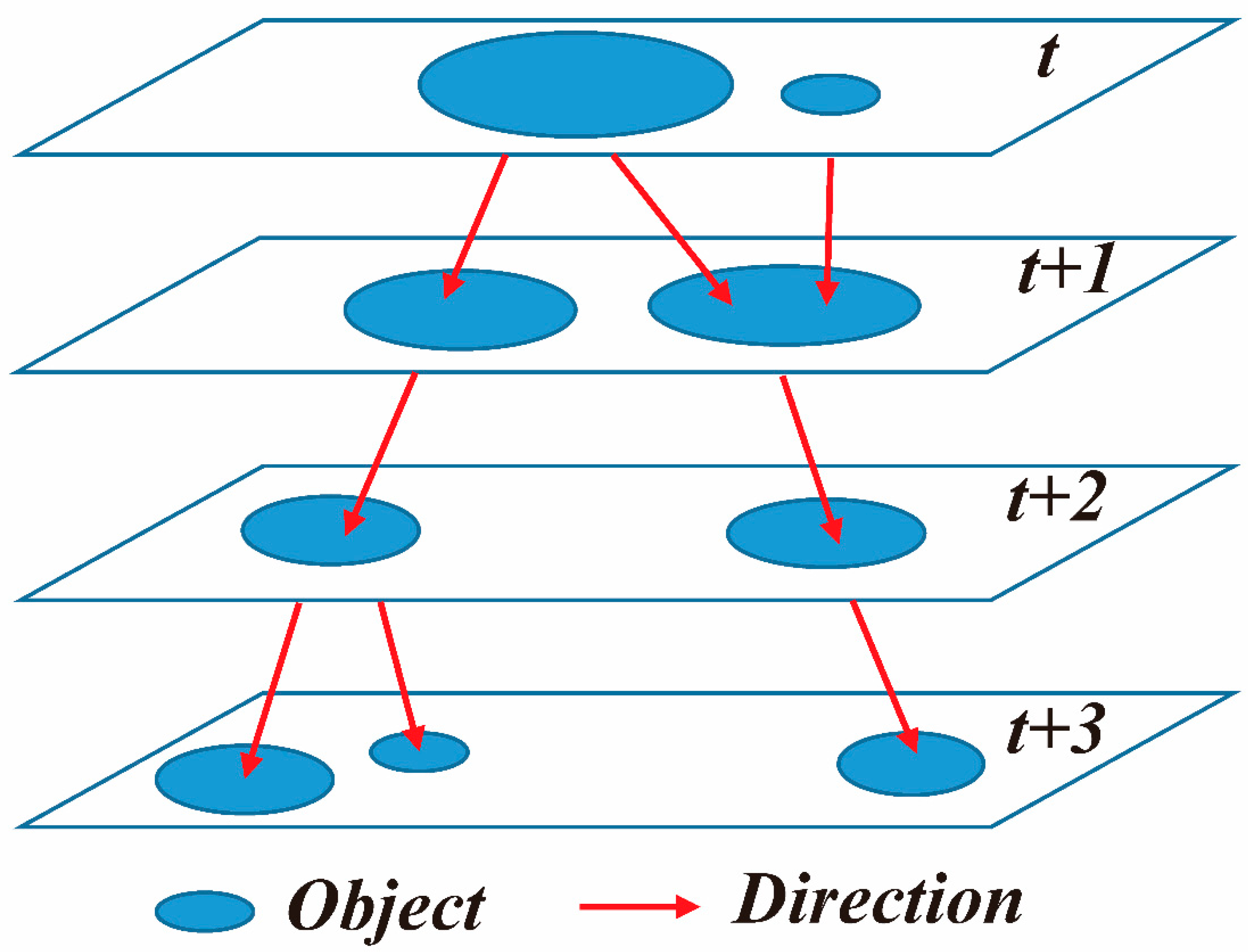
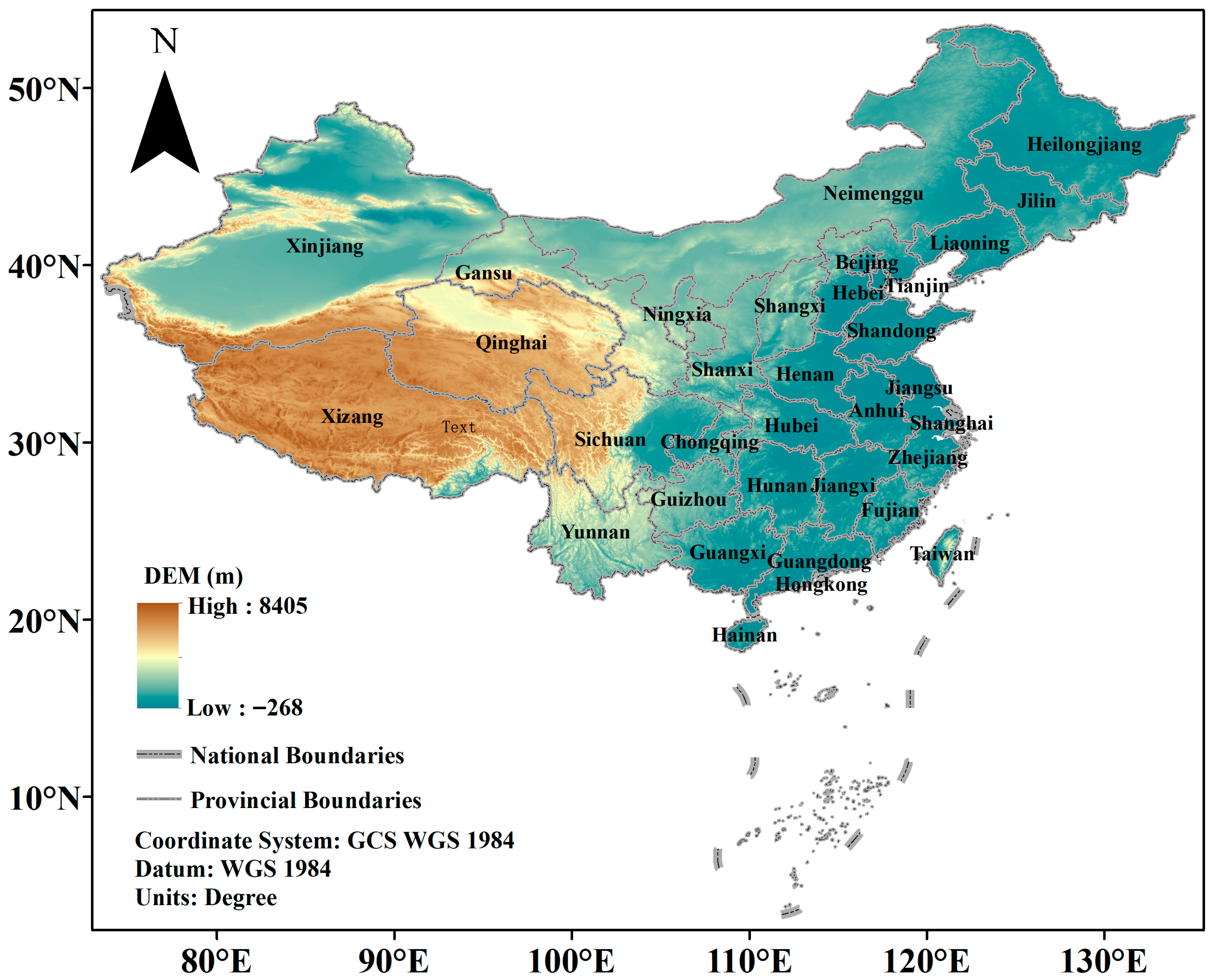
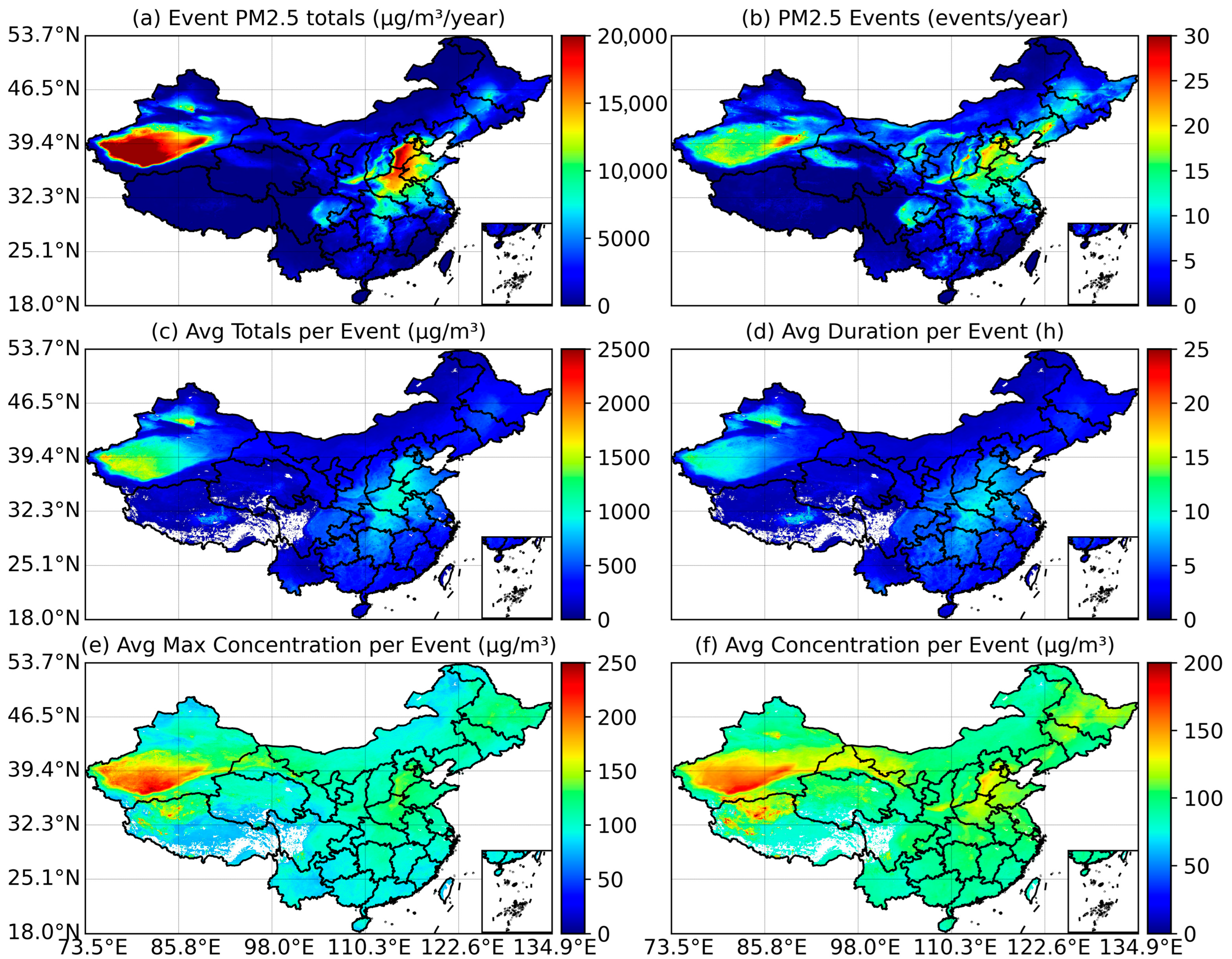
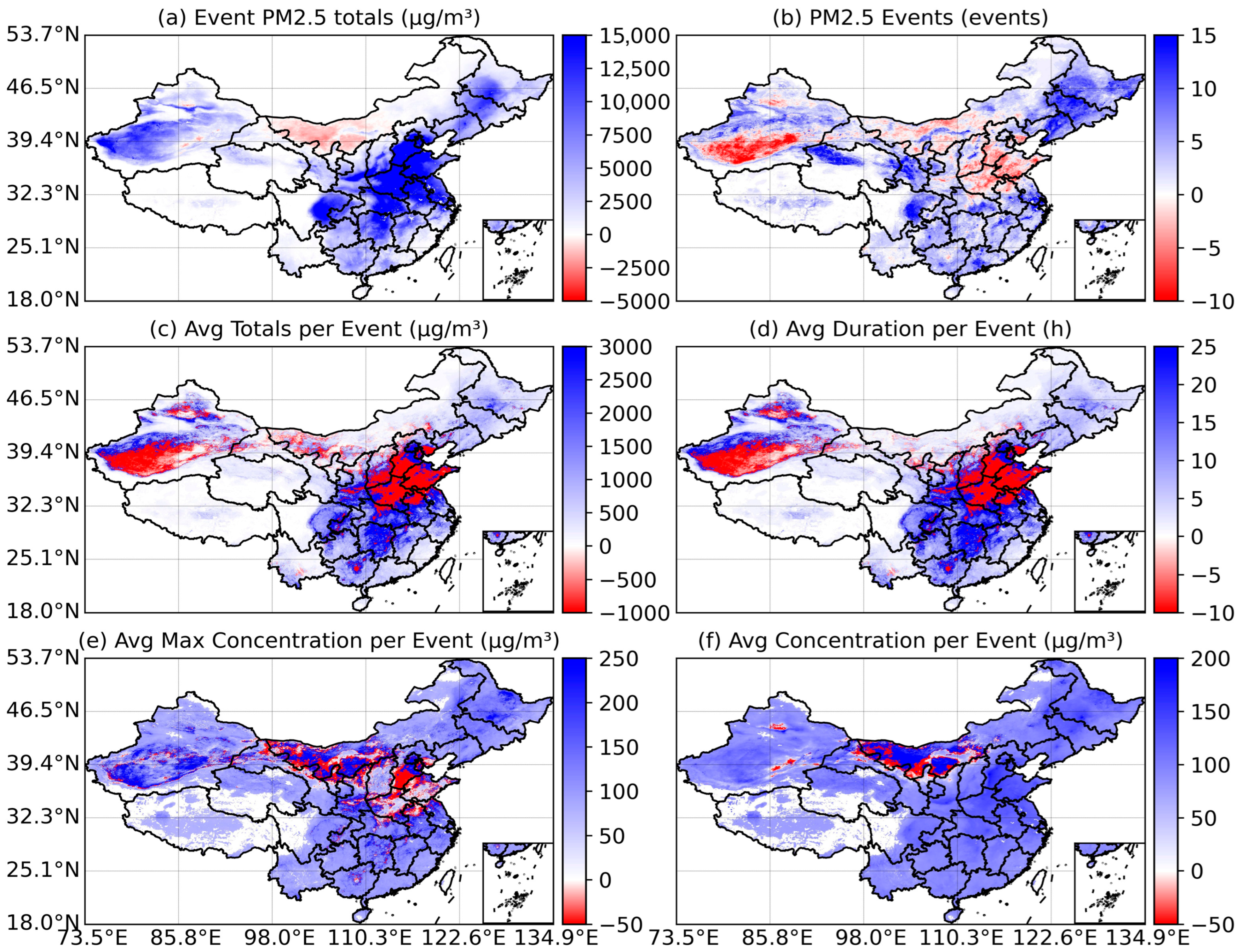

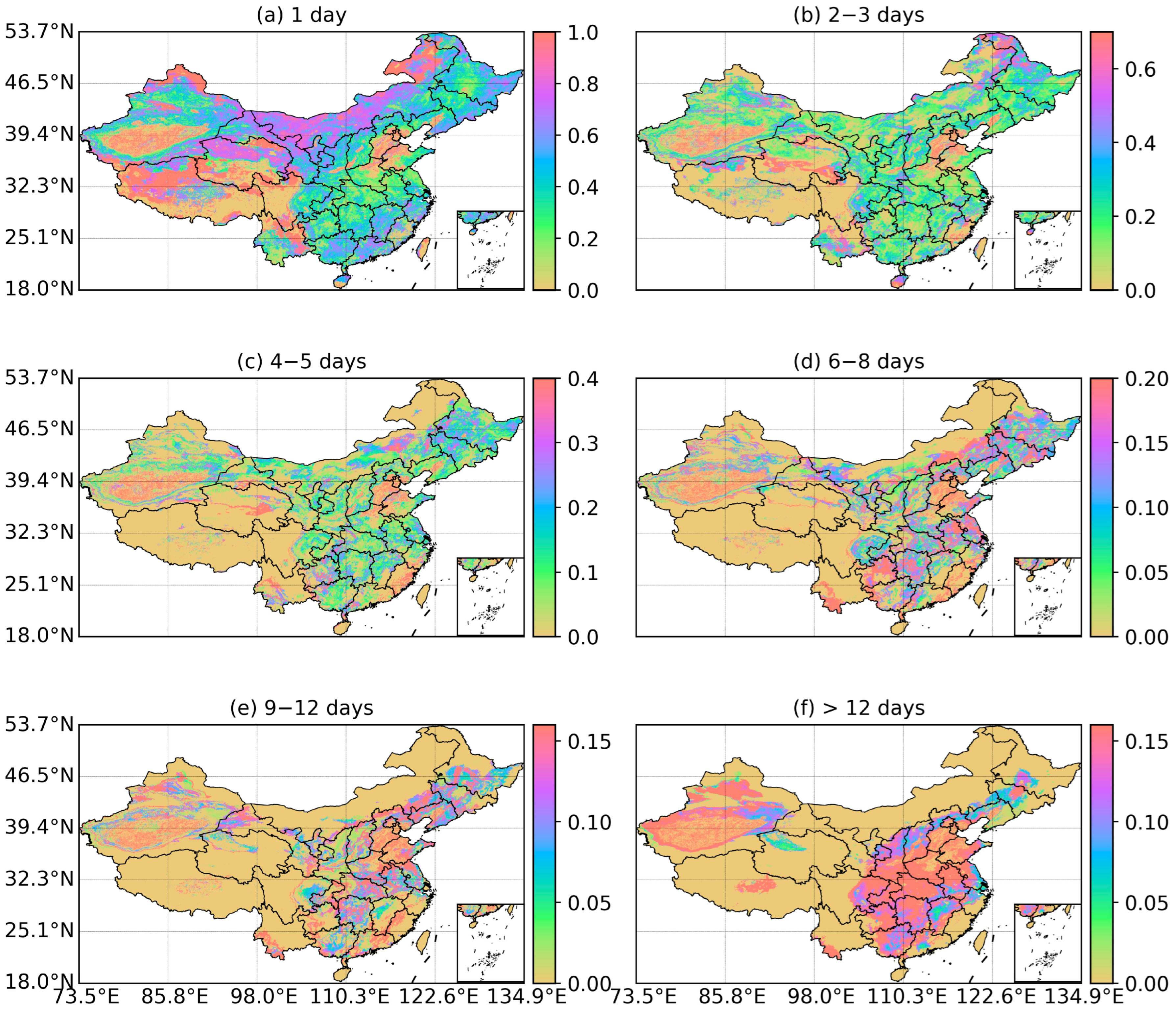

Disclaimer/Publisher’s Note: The statements, opinions and data contained in all publications are solely those of the individual author(s) and contributor(s) and not of MDPI and/or the editor(s). MDPI and/or the editor(s) disclaim responsibility for any injury to people or property resulting from any ideas, methods, instructions or products referred to in the content. |
© 2025 by the authors. Licensee MDPI, Basel, Switzerland. This article is an open access article distributed under the terms and conditions of the Creative Commons Attribution (CC BY) license (https://creativecommons.org/licenses/by/4.0/).
Share and Cite
Zhu, Z.; Li, R.; Chen, Y.; Zhang, Z.; Guo, Y.; Xiong, B.; Zheng, Y. Event-Based Tracking of Spatiotemporally Contiguous PM2.5 Pollution Events in China. Atmosphere 2025, 16, 1182. https://doi.org/10.3390/atmos16101182
Zhu Z, Li R, Chen Y, Zhang Z, Guo Y, Xiong B, Zheng Y. Event-Based Tracking of Spatiotemporally Contiguous PM2.5 Pollution Events in China. Atmosphere. 2025; 16(10):1182. https://doi.org/10.3390/atmos16101182
Chicago/Turabian StyleZhu, Zhihua, Rongjian Li, Yiming Chen, Zhenlin Zhang, Yiying Guo, Bo Xiong, and Yanhui Zheng. 2025. "Event-Based Tracking of Spatiotemporally Contiguous PM2.5 Pollution Events in China" Atmosphere 16, no. 10: 1182. https://doi.org/10.3390/atmos16101182
APA StyleZhu, Z., Li, R., Chen, Y., Zhang, Z., Guo, Y., Xiong, B., & Zheng, Y. (2025). Event-Based Tracking of Spatiotemporally Contiguous PM2.5 Pollution Events in China. Atmosphere, 16(10), 1182. https://doi.org/10.3390/atmos16101182






